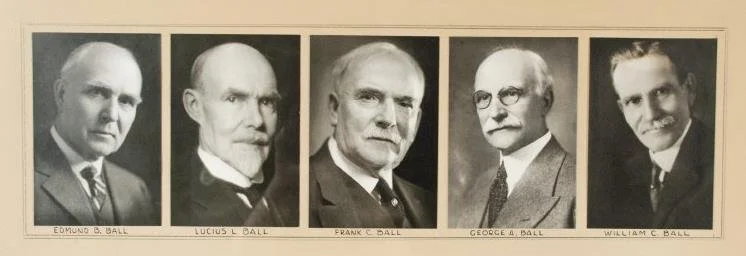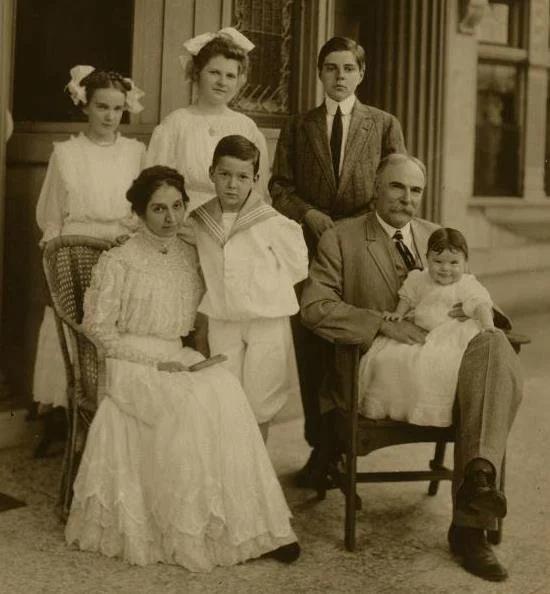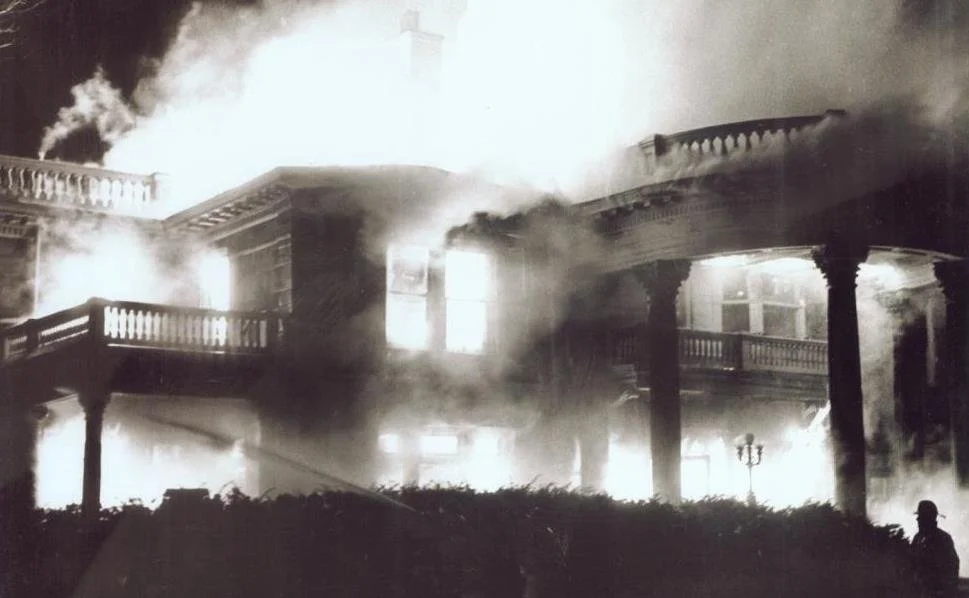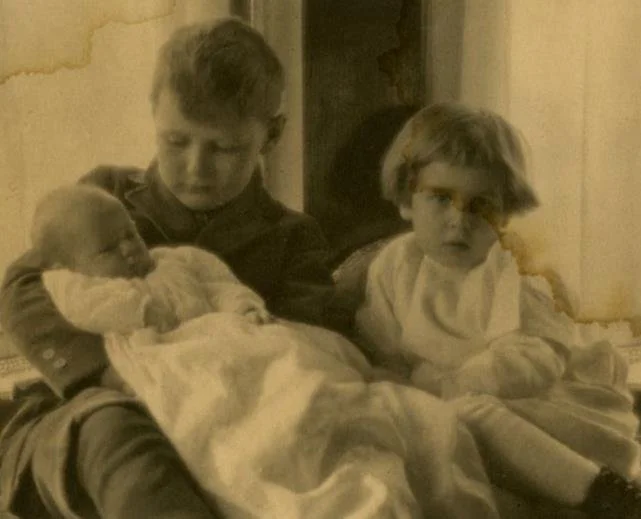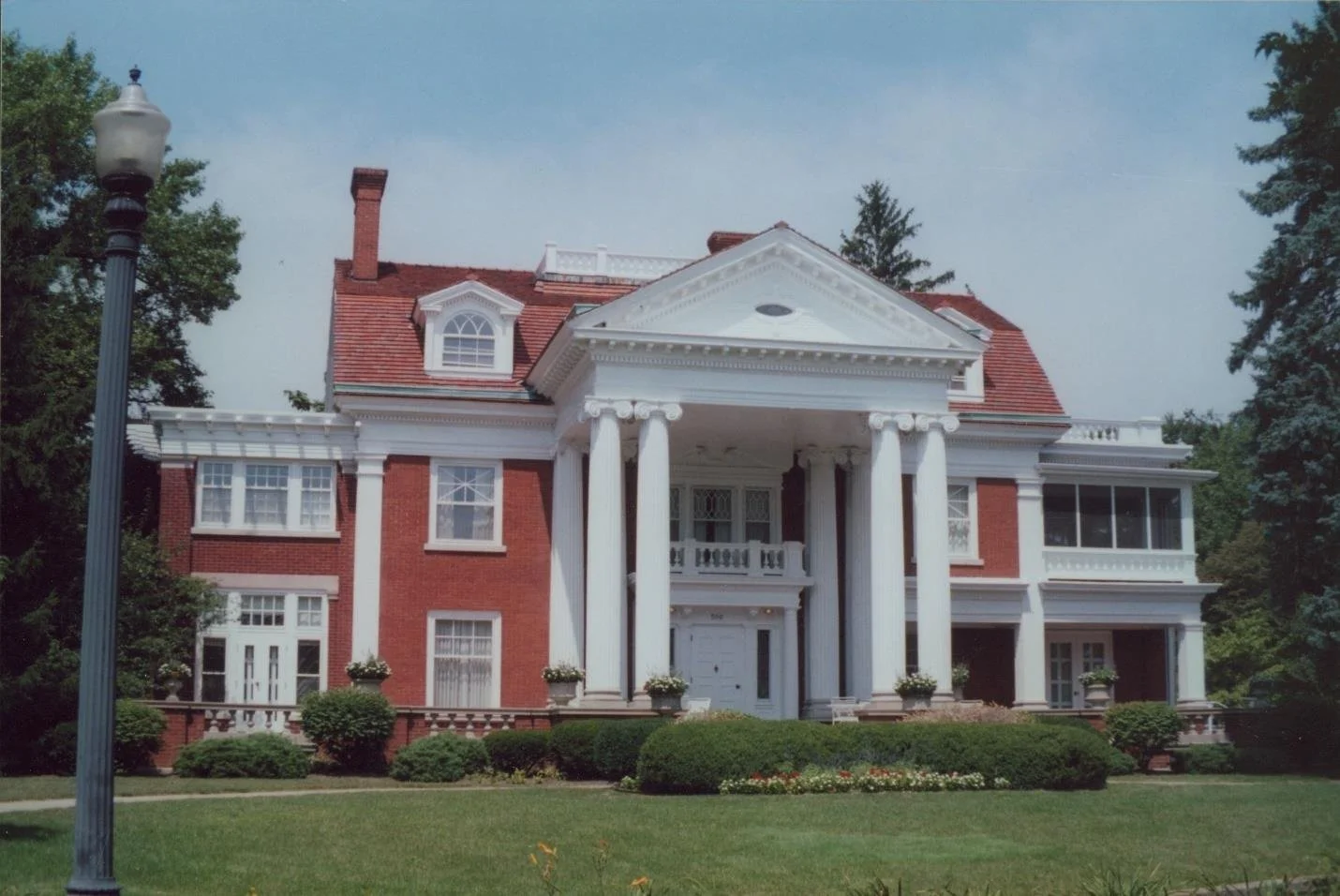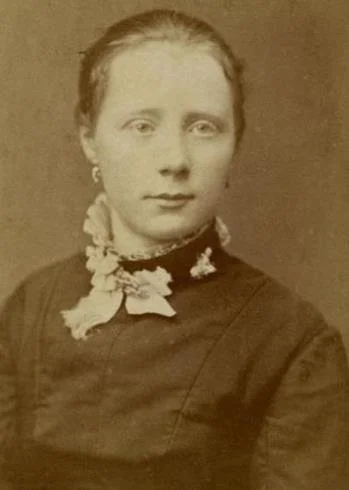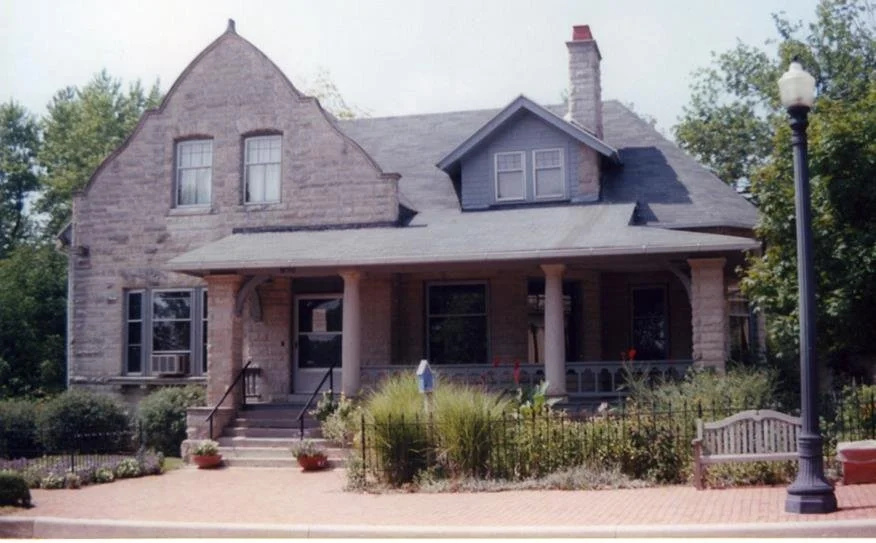The Morbid Question
W. Evan Humphrey, Minnetrista Experience Guide and Archives Intern, February 2025
The five Ball brothers. From left to right: William, Frank, Lucius (seated), Edmund, and George, ca. 1893.
“So...did anybody die in this house?” This is a common question that Minnetrista staff members receive from guests visiting our grounds. While it may seem like a morbid question at first, this is a perfectly normal point of curiosity. The homes along the boulevard range from about 120-150 years old, and, of course, old houses can have a notorious reputation for having people die within them. Sensationalism can easily creep into topics of death, but none of the deaths in any of these homes were of violent nature. Rest assured, all of the people mentioned below died of natural causes.
Now, to answer the question succinctly: yes. Every single home along the boulevard had at least one member of the Ball family (or their extended family) die in them, with twelve people in total dying in the homes. The fact that these people died in the houses should not be the primary focus of their stories or the histories of the buildings themselves. To quote the essay upon which this condensed blog post is based: “The respect for and humanity of the dead can easily be lost when death is the focal point of discussion; it is easy to sensationalize the topic of death. Thus, it has been deemed appropriate, humbling, and humanizing to include details about the homes themselves and the personal lives of those who once called them their own homes. The boulevard is a place rich with history, both in life and in death; as a home is a place where one lives, so too can it be where one dies.”
The brothers in their later years. From left to right: Edmund, Lucius, Frank, George, William.
Minnetrista
Left: Minnetrista home pre-renovation. Right: Minnetrista home post-renovation. The windows to the right of the pillars can be seen in the pre-renovation photograph as well.
The Minnetrista home was where Frank and Bessie Ball lived with their five children. It was originally built in 1894 but was renovated in 1902 to have a limestone façade.
The family that lived in Minnetrista. Back row, left to right: Margaret, Lucy, E. Arthur. Front row, left to right: Bessie, Frank E., Frank C., Rosemary.
The unusual name of the home is said to have come from one of two sources. Some say that several Ball relatives vacationed in Minnesota on a fishing trip, where they visited the Minnetrista River. A local told them that it was a Sioux word that meant “crooked water” or “bend in the river”. Others say that the name is a combination of “minne”, the Sioux word for water, and “tryst”, an antiquated English term meaning gathering or meeting. In this context, “Minnetrista” is thus translated as “gathering place by the water”. Either meaning makes sense, as the home was built near a bend in the White River, and it was often the central meeting location for family get-togethers. Today, the name is used by the modern Minnetrista Museum & Gardens.
The only person to die in the house was Frank Ball, who passed away on March 19, 1943, at the age of eighty-five. He was so passionate about his work and his company that it is said he quite literally kept working from his deathbed.
The Minnetrista home burning on the night of February 28th, 1967.
The Minnetrista home would die as well, in a way, as it unfortunately burned down in 1967. All that would be salvageable were the stone pillars that adorned the outside of the house. These six pillars now mark the entrance to the Minnetrista Center Building, which stands where the original home was once located.
Nebosham
The Nebosham home.
Like Minnetrista, Nebosham is sometimes said to be a word that means “bend in the river”. This limestone house was the last to be built, having been completed in 1907. Edmund B. and Bertha Ball lived there with their four children.
Tragically, one of these children would die quite young. Clinton Crosley, who was often just called Crosley, had his tonsils removed. Though he was recovering well, he unfortunately fell ill and died shortly after the procedure. Some have said over the years that he succumbed to complications from the surgery, but his obituary stated this rumor was unfounded. He is instead believed to have contracted pneumonia, which was unrelated to the surgery. Regardless, Clinton Crosley Ball would die at home on December 12th, 1911, at the age of four.
His father, Edmund, followed fourteen years later. Edmund was regarded as very philanthropic, perhaps the most among his brothers. He oversaw the construction of an athletic field that is now the location of Muncie Central High School and the Muncie Fieldhouse, and he established a summer camp called Camp Crosley in his late son’s honor. Edmund Ball died at home on March 8th, 1925, at the age of sixty-nine.
Left: Three of Edmund and Bertha's children. From left to right: Janice, Edmund F., Adelia. Right: Clinton Crosley Ball.
Maplewood
The family that lived in Maplewood. From left to right: Emma, William H., William C.
Maplewood, named for the maple grove in which it was built, was where William C. and Emma Ball lived with their only child, William H. The Georgian-style home is often admired and beloved by guests who are interested in architecture. It boasts a handsome gambrel-style roof, Ionic pillars, and a Palladian-style entrance.
William C. and Emma would both die in Maplewood. William was a traveling salesman for the company and was known for being very personable. A talented storyteller, he would often regale guests and clients with quotes from literary passages and interesting stories he collected on his travels. He would be the first of the five brothers to die, passing away at home on April 30th, 1921, at the age of sixty-eight.
Emma was a famously kind-hearted woman. She was a staunch supporter of the Humane Society and donated funds to construct an animal shelter in Muncie. One newspaper article described her as “one of those kindly, generous people who derived their chief satisfaction in helping others”. She, too, would die at home on November 14th, 1942, at the age of ninety-two.
Maplewood Home.
Oakhurst
The Oakhurst Home.
The craftsman shingle-style home was where George and Frances Ball lived with their only child, Elisabeth, who was known to friends and family as Betty. The name Oakhurst comes from the grove of oak trees that it sits in, not that the house is constructed of oak, as is commonly assumed. Though much of the interior is indeed oak, the exterior of the house is covered in pine slats.
Elisabeth is now an important and beloved figure here at Minnetrista. On our grounds is a replica of her log cabin, the aptly named Betty’s Cabin, which acts as a play space for children. The annual Faeries, Sprites, & Lights festival is held in honor of her staunch and unwavering belief in faeries.
Contrary to popular belief, however, she did not die at home, though she did live in the house her entire life and was the last member of the Ball family to be living in any of the homes along the boulevard. Her father, George, was the only person to die in Oakhurst. He was known for having kept in close contact with the people who ran the newspapers, often calling them to ask about various facts and clarifications on things he was interested in. George also fostered a lifelong love of learning and literature, to which the expansive Oakhurst library is a grand testament. He would die at home on October 22nd, 1955, at the age of ninety-two.
Left: Elisabeth posing with a book in the Oakhurst library. Right: The family that lived in Oakhurst. Left to right: Elisabeth, George, Frances.
L.L. Ball
The L.L. Ball Home.
This home was where Dr. Lucius Ball, his wife, Sarah, and their daughter, Helen, lived. It was the only home on the boulevard to have already been there when the brothers moved to Muncie from Buffalo, New York. It was also the only home that was not bestowed with a unique name; many people just called it “the doctor’s house”. Originally a Queen Anne-style farmhouse, probably constructed around the 1870s, it was renovated in 1913 to its current Federalist style. The L.L. Ball Home is most famous for its history as a television station, WIPB, which was where Bob Ross filmed fourteen seasons of the beloved PBS program The Joy of Painting from 1983 to 1988.
Lucius was, among his brothers, the least involved in the family company. It seems he did not particularly care for entrepreneurial affairs; rather, he was a physician and operated a clinic in his home. Around town, he was well-known for traveling to appointments and house calls on his trusty bicycle. No patients died in the L.L. Ball Home under his care, but Lucius would die at home on July 22nd, 1932, at the age of eighty-two.
Personality wise, Sarah was the yin to Lucius’ yang. While Lucius was soft-spoken and reserved, Sarah’s many nieces and nephews spoke fondly of her jolliness and sense of humor. The couple were also alike, however, in that they both had an interest in medicine; Sarah went to nursing school and was very philanthropic and passionate regarding Muncie’s medicine-related matters. Sarah, too, died at home on June 11th, 1952, at the age of ninety-four.
Left: Helen and Lucius, ca. 1896. Right: Lucius and Sarah, with the former posing with one of his trusty bicycles.
Mary Lincoln Cottage
Mary Lincoln.
This little Gothic-style stone cottage on the end of the boulevard was where several extended family members of the Ball brothers lived, though the history in this regard is murky and complicated. (See the blog post “The Stone Cottage” by Nalleli Guillen for more information!)
Regardless, it was indeed where four people would die. A common misconception is that the infamous incident of two members of the family dying in the same house on the same day occurred in the Mary Lincoln Cottage. While the story is true—the Ball brothers’ mother, Maria (pronounced mah-RYE-ah, not mah-REE-ah), and one of their cousins, Clarence Harvey, did indeed die in the same house only hours apart from each other—it happened in a different house ten years before the cottage was built.
The first occupants of the cottage were Martha Harvey, an aunt of the Ball brothers, and Elvie, her late son Clarence’s widow. Martha died at home on February 20th, 1906, at the age of seventy-four.
Elvie would shortly thereafter move out, and the Lincoln family would move in. The Lincolns were Lucina, another one of the brothers’ aunts, Isaac, her husband, and Mary, their daughter. Mary Lincoln (who had no relation to Abraham Lincoln’s wife) was the namesake of the home, as she lived there the longest and was the most well-known resident.
All three members of the Lincoln family would die in the cottage as well. Isaac died on December 12th, 1908, at the age of eighty-six. His widow, Lucina, died on September 20th, 1912, at the age of eighty-two. Mary, who was a beloved cousin of the Ball brothers and had worked for the Ball company for many years, died on October 5th, 1950, at the age of eighty-seven.
The Mary Lincoln Cottage.
To reiterate, twelve people in total died in the homes along the boulevard. This may seem like quite a few, but in a way, it is not. The math works out to about 40% of the boulevard’s residents having died at home. In recent years, the number of terminally ill patients who choose to die at home is about 31%, which is the highest it has been in decades. In the early part of the 20th century, 40% of people dying at home could very well be expected, if not lower, than the average. Going to a separate dedicated medical facility such as a hospital, nursing home, or hospice center for end-of-life care is a relatively recent idea. For most of human history, dying at home was the norm.
So, remember this if the thought of death in these homes unnerves you: these people died in places that were comfortable to them, surrounded by their loved ones, at a time when this was to be expected. Their beautiful homes and fascinating legacies are treasured and remembered to this day. When put into this context, that does not seem like such a bad way to go after all!
For further information about this topic, please see the essay “The Morbid Question: ‘So... Did Anybody Die in This House?’”, also written by W. Evan Humphrey.

